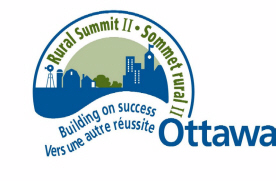(Do you have a story, or comment or idea for this page? Contact us.)
|
Rural News Headlines |
Local farmers can join food guide
Farm Financial Survey
Farmers plant willow as energy crop
Using genetics to stamp out bugs
Farmers reminded to register their farm business
Organic crops healthier for soil
Outback 360 offers a bird's eye view of fields
by Laura Cummings (Courtesy OttawaEast.ca)
 Hoping to bring further improvements to Ottawa’s rural sections and increase dialogue with that area’s
population, the city will hold its second rural summit in coming weeks.
Hoping to bring further improvements to Ottawa’s rural sections and increase dialogue with that area’s
population, the city will hold its second rural summit in coming weeks.Residents from the east end’s outlying areas are invited to attend Rural Summit II – Building on Success on April 5 at Confederation High School, which is located at 1645 Woodroffe Ave.
Ottawa’s first rural summit was held in the fall of 2005, after results from the 2004 Citizen Satisfaction Survey illustrated that the city’s rural residents were considerably less happy with municipal services than urban dwellers. Participant recommendations from the city-hosted event – which boasted over 400 attendees – ranged from creating a rural section on the city’s website to allocating a greater portion of the city budget for road maintenance in rural areas.
Derrick Moody, rural affairs officer for the city, explains that next month’s event is being framed as a follow-up to the original summit, as well as the continuation of an ongoing initiative. Read full story.
Check out the City of Ottawa's Web site for Rural Summit II - where you can get all the information on the upcoming summit, including the results of the First Rural Summit, and a Sign up link for Rural Summit II e-mail updates.Click here.
By Patrick Meikle
Local farmers who live within the City of Ottawa and the surrounding Ottawa Valley and who
have farm-gate sales of fruit, vegetables, eggs, dairy, meat, honey, syrup, etc., may wish to be a part of the
new Ottawa Buy Local Guide coming out this May.
There is no cost to you -- the Ottawa Food Security Council (OFSC) is creating, printing and distributing thousands of copies of a Buy Local Guide throughout Ottawa,
highlighting local farms like yours, how to get to you, what you sell, and when you are open.
Moe Garahan, speaking for the OFSC says: "The
idea behind the food guide is to give farmers access to the local markets and at the same time help to build consumer
awareness within the local communities and encourage people to buy local brands specific to this area."
The Council is also developing a printed map of the City of Ottawa to show the public where the farms are located,
directions on how to get there and a list of what products they sell.
Garahan says "the Council wants to promote local farmers, find out what they think would work, find out what
barriers they face and look at rural/urban issues."
One of the Council's initiatives is to develop a "Buy Local" campaign and logo, similar to the Foodland Ontario guide. Besides this campaign, the Ottawa Food Security Council is focussing on other program areas. They include:
- Spring gardening workshops
- Facilitation of a Community Kitchen Network
- Developing a compendium of municipal policies that impact on food security
- Organizing Ottawa Harvests: Food and Ideas on October 16, World Food Day
The Ottawa Food Security Council is composed of farmers, restauranteurs, food processors, chefs, to name a few. It started its work in April 2003. The Council has a part-time co-ordinator and includes a diverse group of individuals interested in the complex organizations, transactions and issues that make up our local food systems.
To be part of the Guide, to get your farm on the map or to get more information, please contact the OFSC at 236-9300, Ext: 301 by March 31st, 2005 and leave them your contact information. They will contact you to confirm what information you would like in the Guide.
To see a draft example of the map or obtain further information regarding the project, you
can also visit their web-site at www.spcottawa.on.ca/ofsc.
![]() Back to top
Back to top
The Farm Financial Survey (21F0008XIB, free) will be available in December on Statistics Canada's Web site (www.statcan.ca). From the Our products and services page, choose Free publications, then Agriculture. It will also be available on Agriculture and Agri-Food Canada's Web site.
To order data, contact Client Services (613-951-5027; agriculture@statcan.ca). For more information, or to enquire about the concepts, methods and data quality of this release, contact Phil Stevens (613-951-2435; stevphi@statcan.ca), Agriculture Division.
Farmers plant willow as energy crop
Don New was phasing out his dairy operation and looking to grow something besides
corn and soybeans when he first got wind of willow. Not the weeping tree, but a fast-growing shrub touted as a
source of clean, renewable energy with the potential to reduce harmful power plant emissions and support the local
farm economy.
Willow sprouts vigorously after cutting, so it can be harvested every three or four years without replanting.
Willow shrubs, touted as a renewable energy source, surround researcher
Larry Abrahamson and Tim Volk, director of the State University of New York's
College of Environmental Science and Forestry, on a farm in Canastota, N.Y.
Click here for more.
It beats a rolled up newspaper: British scientists have developed a new breed of sterile bugs that could slash insect numbers without the need for costly and environmentally damaging pesticides.
DR. LUKE ALPHEY and colleagues at Oxford University say they have established a spin-out company, Oxitec, to commercialize the process and are already discussing control of cotton pests with the U.S. Department of Agriculture.
Sterilization itself is not new. It has been used to control cattle screwworm in North America and Libya, and to control tsetse flies on the Tanzanian island of Zanzibar.
But the standard method of sterilizing males using radiation has serious drawbacks because it often damages the insects which reduces their effectiveness.
To get round the problem, the Oxford scientists have genetically modified their bugs, altering the creatures’ metabolism so that they are dependent on a dietary supplement used in the rearing program.
“Our technique improves on the current approach as the released insects will be sterile but not damaged by the treatment and so can compete effectively with wild insects,” Alphey said.
The Oxitec insects, when released, mate with their natural pest counterparts and transfer their lethal gene before they themselves die, thereby controlling the population.
Cheap and non-toxic pest control could be a boon for both livestock and arable farmers, as well as improving human health in developing countries.
The United Nations earlier this year lent its support to an ambitious campaign to wipe out the deadly tsetse fly from nearly 10 million square kilometers of sub- Saharan Africa, by releasing millions of irradiated male insects.
The biting tsetse fly transmits a deadly parasite, trypanosome, which attacks the blood and nervous system of its victims, causing “nagana” in livestock and “sleeping sickness” in humans.
Farmers who have not registered their farm business with AGRICORP's Farm Business Registration Program must do so now.
Under the Farm Registration and Farm Organizations Funding Act, Ontario
farmers who have a gross farm income of $7,000 or more per year are required
to register their business. The farm business registration number is one of
the eligibility criteria for the Farmland Property Class Tax Rate and the
Ontario Farm Income Disaster Program. Click here.
|
Pieter Biemond has been growing certified organic crops and producing organic milk from 40 cows near Morrisburg for a dozen years, and has noticed something strange: His soil is getting easier to work. Read Tom Spears report from the Ottawa Citizen. Click here.
|
|
|
 The new Outback
360 is a computerized visual aid system. It features a high-resolution color display screen that offers farmers
a 360-degree bird's eye view of their fields. Using the Outback 360 in conjunction with the Outback S, farmers
can effectively look down from the sky - monitoring the progress of their tractors, sprayers, cultivators and other
farming equipment as they move across fields. Click
for more.
The new Outback
360 is a computerized visual aid system. It features a high-resolution color display screen that offers farmers
a 360-degree bird's eye view of their fields. Using the Outback 360 in conjunction with the Outback S, farmers
can effectively look down from the sky - monitoring the progress of their tractors, sprayers, cultivators and other
farming equipment as they move across fields. Click
for more.  An Agri-Business Corporation
driven to provide innovative risk management tools for Ontario farmers! Click for more. An Agri-Business Corporation
driven to provide innovative risk management tools for Ontario farmers! Click for more. |
|
| The Canadian Agriculture Library is Canada's foremost agriculture library, providing a wide range of information services to the Department, Canadian Food Inspection Agency, the research and academic community, the agri-food industry and the Canadian rural sector. CAL holds a comprehensive collection on agriculture and food in Canada, with close to 1 million volumes, 3,000 current subscriptions and numerous special collections. | |
| The Canadian Federation of Agriculture was formed in 1935 to answer the need for a unified voice to speak on behalf of Canadian farmers. | |
| The Eastern Ontario AgriNews is dedicated to covering and promoting agriculture, one of Easten Ontario's most important economic sectors. It is published on the third Monday of each month. The printed version is distributed free by postal mail to farms in Eastern Ontario, Canada. | |
| The Food Safety Network is at the University of Guelph. FSNet, AgNet, AnimalNet and Functional FoodNet provide current, generalized, public risk perception information about rapidly changing issues. This information is culled from journalistic and scientific sources around the world and condensed into short items or stories that are distributed daily by electronic mail to thousands of individuals from academia, industry, government, the farm community, journalism and the public at large. | |
|
|
Livestock Weekly An American publication catering to the livestock owner and breeder; featuring markets, news, buyer's directory, cartoons, and more. |
| Ontario Plowmen's Association The OPA is the parent host of the International Plowing Match and Farm Machinery Show. Each year the OPA partners with a local plowing association to organize and host the IPM. |
|
| l'Union des Cultivateurs Franco-Ontariens La source d'information indispensable pour le monde de l'agriculture ! |
|











